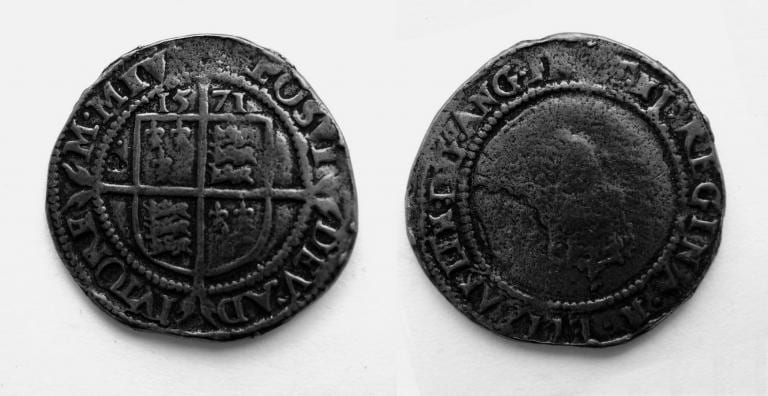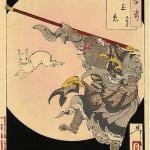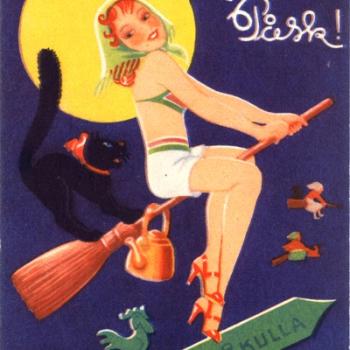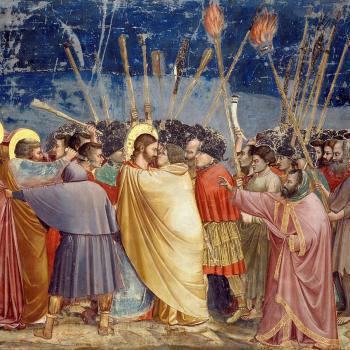Like many cultures and countries, Britain and America share a rich history of fairy and otherworld encounters, healing, love tokens and divination lore. Among the history of these, the sixpence features frequently, being an identifiable, valuable and readily available charm. The silver sixpence has been identified in many cases as amulet, touch piece, symbol of love, magical token, witness and seal of a vow, and more.

The sixpence, a ‘tanner’, is a British coin denomination with the value of one fortieth of a pound. The first sixpences were minted by King Edward VI and have been produced during the reigns of every monarch since. Magically, the significance of the sixpence requires little investigation and produces many avenues of insight. The number six, being a multiple of the Trinity, would always have an obvious relevance to the Catholic and Protestant Brit and its colonies, while the silver content aligned it squarely with lunar correspondence. Needless to say, the popularity of the sixpence as a magical item achieved some prominence during the reign of Queen Elizabeth I, aligning the coin with the feminine principle, while featuring the Tudor Rose emblem, as well as a crossed shield on the obverse.
The significance of the ‘crooked’ coin requires a little more understanding. Combining the Christian sensibilities of the time with pre-Christian ideas of a sacrificial object made by “killing” it, as well as the making of promises, the crooked sixpence may have originated in the 14th Century English custom of bending a coin “…as part of a vow to a particular saint” (Cofield, 2014). This alignment with Catholic magic and the cult of the saints introduces the idea that there is, perhaps, a continuation of a pre-Christian custom in the sacrifice. It is interesting to note that peoples such as the ancient Britons folded metal objects (ritually killing them) before casting them into lakes and rivers (sacrifice), while the Vikings bent swords and ingots they buried. Sara Rivers Cofield (Keeping a Crooked Sixpence: Coin Magic and Religion in the Colonial Chesapeake) asserts the custom whereby the coin, charged with a vow to a particular saint, was bent or doubled over to seal the spell for a particular time, occurrence or both. In this manner, it was used to cure the sick, trap disease or injury, turn back flame, wind and weather.
In the wake of the Hallowe’en season, there is an interesting tale from Ireland which recounts the story of ‘Stingy Jack’, who tricks the devil in a Faustian pact. Due to his poor condition, Jack cunningly entices the devil to change himself into a sixpence which is then quickly concealed in Jack’s wallet and confined there by a silver cross. This recalls the trapping of the spirit of the spell or charm, vow or oath, as well as the compact with the Saint, which is confined in the act of making the coin crooked. In so doing, Jack captured the devil and continued unharmed. Later, he releases the devil under promise to leave him be. However, after some considerable time, Jack finds himself at a crossroads and he knows that the devil is there waiting to claim his due and take Jack’s soul. However, Jack, being canny, understands that the crossroads is another spirit trap and he makes short work of tricking the devil again, this time with that underworld symbol of an apple tree from which the devil climbs to pick the fruit. Stuck in the tree, the devil is outwitted once more. The story goes that, when he did eventually die, Jack was refused entry into Heaven for his truck with the devil, while the devil himself denied him even Hell for his trickery. For ever more, therefore, Jack was destined to travel between the worlds, with naught but a turnip with a smouldering ember to light his way.

Hallowe’en tale concluded, we have some small idea of the powers that the sixpence could harness in its use. The very word ‘crooked’ perhaps derives in Middle English from the Old Norse krókóttr ‘crooked, cunning’, to signify bent, or hooked like a shepherd’s ‘crook’. In addition, however, it is also used to denote the act of a swindler, trickery, and is especially used in the Middle Ages in reference to the devil and his wily ways. In the Bible, the English word ‘crooked’ is used in reference to the serpent, Leviathan, most commonly in Job and Isaiah, and is most significantly a reference to the constellation of Draco, the dragon, which coils about the celestial axis of the North Star. The association with definitions which signify ‘cunning’ are undoubtedly relevant to us in the context of historic magical operators known collectively as cunning folk. These were the ones who knew the secret and occult ways of working, whether with angel or devil alike.
Finally, it would be remiss to discuss the sixpence without reference to the fairy lore, which often has the silver coin as a type of offering, sacrifice, bribe or payment to the fairy folk. Although, like the devil or devils, it is advisable always to be on guard as the tricky nature of the spirits of fairy can be used to trap us.
This brief exploration offers just some small insight into the many reasons why it may be advisable to keep a crooked sixpence.

References:
Sara Rivers Cofield, Keeping a Crooked Sixpence: Coin Magic and Religion in the Colonial Chesapeake, Historical Archaeology, 2014, 48(3):84–105.


















